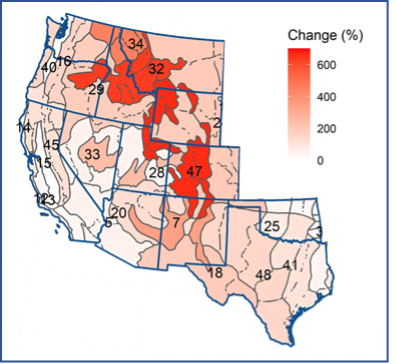The current drought in the Southwestern U.S. has broken records that have stood for a very long time. A new study by Dr. Park Williams, et al., estimates that the drought conditions experienced from 2000 to 2021 by California, Nevada, Utah, and Arizona, as well as most or parts of seven neighboring states are the most severe since the year 800.
The authors reconstructed the history of drought by way of a water balance model for the period 1900 to the present, using observation data on precipitation (supply) and evaporation (demand), where evaporation is a function of humidity, wind, and radiation. For the earlier centuries, for which observation data is not available, tree ring data were used to reconstruct drought severity. Not surprisingly, wide rings indicate rapid growth made possible by abundant soil moisture, while narrow rings indicate soil moisture deficits.
Results show that the 22-year period from 2000 to 2021 can not only be categorized as a “megadrought” (a severe drought lasting for at least two decades) but is also the worst megadrought since the late 800s. (Interestingly, the current study builds on one published two years ago covering the period 2000-2018. In that, the authors found that the 19-year period—not quite long enough to be considered a megadrought—was second in severity to a megadrought that occurred in the late 1500s. However, the exceptionally dry conditions of 2020 and 2021 served to elevate the current drought both to megadrought status and to the number one position. Indications are that drought conditions will continue through 2022.)
Why Is It Happening?
Williams et al. point out that megadroughts occur amid Earth’s natural climate variability. We have little insight into the drivers of four that occurred in pre-industrial times. But what of the current drought?
The Southwestern U.S. has experienced below average rainfall during the last two decades. Not in every year, certainly, but in most. This is likely due, in part, to the fact that the La Niña phase of ENSO has been dominant over the tropical Pacific during that period. La Niña is characterized by a high-pressure ridge over the central and eastern Pacific, which reduces cloud formation and precipitation in the southern half of the U.S. It also results in higher-than-normal temperatures.
The real driver of the current megadrought, however, is not so much the lack of precipitation on the supply side, which shows no trend as yet, but rather rising temperatures due to anthropogenic climate change. On the demand side of the water balance model, rising temperatures increase evaporation and aridity. In fact, using now well-accepted event attribution techniques, the authors estimate that anthropogenic climate change accounts for 42% of the soil moisture deficit in the region and hence the severity of the drought. Looking a bit further back, Abatzoglou and Williams (2016) estimated that rising temperatures due to climate change are responsible for over half of the documented increase in the aridity of forests across the Western U.S. since the 1970s—the forests that fuel wildfires—and that this warming has doubled the cumulative forest fire area since 1984.
Can a wet year put an end to our megadrought? Unfortunately, likely not. Some hoped so after a very wet 2019, yet 2020-21 saw a return to extreme drought conditions. The bad news is that drought begets drought. That is, high mean temperatures prime the climate system to reach extreme temperatures more easily. Very warm air over a region distorts the flow pattern at upper levels, so rain-laden weather systems are diverted. As the land surface dries out, the air warms even more because there is little evaporative cooling to counter the heating. The process spawns a positive feedback loop that exacerbates aridity and prolongs drought conditions.
Drought and Wildfire
So, are severe wildfire seasons such as 2017, 2018, 2020, and 2021 destined to become the new normal? Drought is certainly an important ingredient for wildfire, but it’s not the only one. Bradstock (2010) notes that four “switches” need to be activated for wildfire to occur: (1) fuel abundance; (2) fuel dryness; (3) suitable weather conditions for fire spread, and; (4) a source of ignition, typically from humans or lightning.
For the near and intermediate future and despite increased rates of tree mortality due to drought-induced water stress and insect infestation, there remains a lot of forest to burn. There is a growing recognition that the focus cannot be only on putting wildfires out but must also be on preventing their ignition and spread. Forest management will be critical and indeed California announced in January 2022 new initiatives to remove the excess and dangerous buildup of vegetation within forests.
But what of other fuel types? Here, the inter-seasonal cycling between precipitation and drought becomes critical. A wet winter can be followed by explosive vegetative growth, as happened in California in 2016-2017. Summer brought back drought conditions producing a bounty of dried-out vegetation that acted as a perfect conductor for wildfires. If wet winters become increasingly infrequent, however, are wildfires ultimately limited by fuel availability? At some point in the future, does desertification put an end to wildfire risk in America’s Southwest?
What’s Ahead?
Global climate models (GCMs) are in agreement that drought will continue to increase in severity. In the Southwestern U.S., the impact of climate change on precipitation is still unclear. But temperature effects outweigh precipitation effects on drought conditions, and temperatures will continue to rise, at least in the near and intermediate future, albeit at a rate that depends on global mitigation efforts. Some studies (Cai et al. 2022) suggest an enhancement of La Niña as part of the ENSO cycle meaning that high temperatures will be further exacerbated.

In a report prepared by Verisk for the Society of Actuaries, we concluded that for forested ecoregions of the Western U.S., the prognosis is not good (see Figure 1)—at least under a “business as usual” climate scenario that assumes continued fossil-fuel development. We also recognize multiple and potentially significant sources of uncertainty, among them uncertainties inherent in the GCMs themselves and their sensitivity (to humidity, for example), and in the climate scenario (business as usual) selected for the study. The current generation of GCMs (CMIP6) cannot predict how the frequency of lightning may change. As for human activity, we can hope that power lines will become more resilient to high winds and that humans will simply be more careful. Broader questions include whether regional vegetation will adapt, or it may be that more drought and fire-resistant vegetation will migrate to take the place of drought sensitive plants.
While the impacts of climate change are highly variable around the world, the future for drought and associated wildfires in the Southwestern U.S. is bleak. If there is reason for optimism, it comes from the latest report from the IPCC, which argues that the worst impacts can still be averted—if we act in time.
Understand and manage fire risk with Verisk wildfire and bushfire models.




